::: PROVISIONAL GOVERNMENT :::
|
|

|
PROVISIONAL GOVERNMENT ISSUE OF 1893
|

|
Queen Liliuokalani was deposed in a bloodless revolution on January 17, 1893. Hawaii's new leaders created a
provisional government and sought quick annexation to the United States but politics in America got in the way
when a new administration was inaugurated, sympathetic to the Hawaiian royalty. As the weeks passed, it became
evident the provisional government would need to govern rather than be a temporary caretaker.
Joseph Oat replaced the ailing Walter Hill as Postmaster General shortly after the Provisional Government seized
power. Hawaii's postage stamps with portraits of the royals were embarrassing to the revolutionaries but ordering
new stamps would take time and also might be a total waste of money if the mood in Washington, D. C. came around
to favor annexation. Oat recommended overprinting the Royal Portrait stamps
(See Bank Note Stamps) as a quick and cheap option. Hawaii's provisional cabinet
approved the idea.
|

ESSAYS
Once it was decided to overprint the stamps, Oat made some overprint essays for design approval. A card in the
effects left by PMG Oat bears a set of the essays along with an example of a fraudulent overprint.
|
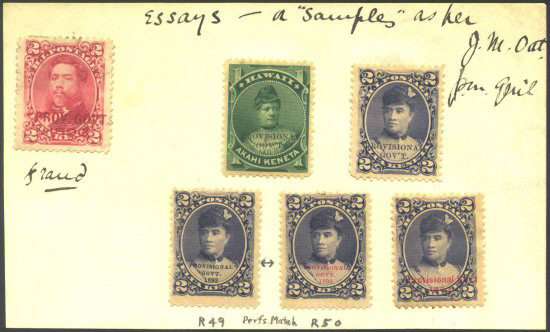
|
|
Card found in PMG Oat's effects. Single clichés were used to create three styles.
|
|
|
|
PROVISIONAL
GOV'T.
|
|
|
PROVISIONAL
GOVT.
1893
|

|
|
Provisional GOVT.
1893
|
|

APPROVED DESIGN
A design was approved and the stamps were sent to the Gazette Company to be overprinted. Red ink or black ink was
used in the process of overprinting depending upon which gave the better contrast.
|
|
|
MAY 20, 1893
Knowing Hawaiian stamps were especially popular with stamp collectors worldwide, Oat used newspapers and other
publications to broadcast Hawaii's decision to overprint the remaining portrait stamps. He announced plans to have
them on sale to the public on May 20, 1893. Dealers, collectors and speculators from the United States and Europe
flocked to Hawaii to attend the event and secure stocks.
May 20, 1893, became chaotic around the Honolulu Post Office as speculators, stamp dealers and stamp collectors
crowded the room and flowed out into the street. For several days, other work of the Post Office virtually ceased
as regular patrons were unable to get through the swarm.
|

GALLERY
Red Overprints
|
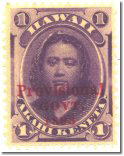
|
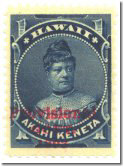
|

|
|
Scott No. 53
|
Scott No. 54
|
Scott No. 55
|
|
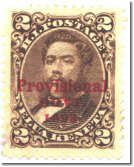
|

|
|
Scott No. 56
|
Scott No. 57
|
|

|

|
|
Scott No. 58
|
Scott No. 59
|
|
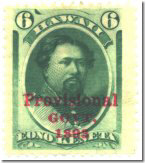
|

|

|
|
Scott No. 60
|
Scott No. 61
|
Scott No. 62
|
|

|

|
|
Scott No. 63
|
Scott No. 64
|
|

Black Overprints
|

|
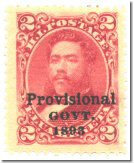
|
|
Scott No. 65
|
Scott No. 66
|
|
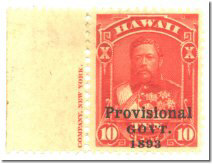
|
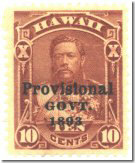
|
|
Scott No. 67
|
Scott No. 68
|
|

|

|
|
Scott No. 69
|
Scott No. 70
|
|
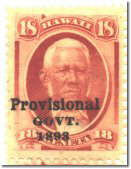
|

|
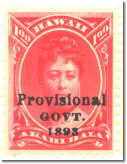
|
|
Scott No. 71
|
Scott No. 72
|
Scott No. 73
|
|

Color Errors
Two errors of color were made. One sheet of the 6¢, normally printed in red, was printed in black, and one sheet
of the 10¢ red brown, normally printed in black, was printed in red.
|

|

|
|
10¢ color error
Scott No. 61B
|
6¢ color error
Scott No. 66C
|
|
FOUR OVERPRINTINGS
In all there were at least four distinct overprintings.
- The first was in April and May, 1893. The first overprinting included all of the overprinted stamps except
one, the 12¢ red lilac with red overprint, Scott No. 63.
- The second overprinting was in early June. This overprinting included Scott No. 63 and added additional
supplies of Scott Nos. 53, 54, 56, 58, 60, 67 and 70.
- The third overprinting, done in late June, 1893, consisted of a second overprinting of Scott No. 66.
- The last overprinting began in November, 1893, and continued probably into 1894. This last overprinting
made additional supplies of Scott Nos. 55, 57, 58, 59, 61, 62, 64, 68, 71, 72 and 73.
Scott Nos. 65 and 69 appeared only in the First Printing. Scott No. 63 appeared only in the Second Printing. All
of the others (excluding older stamps - see below) were printed in more than one printing. Each of the Printings
is unique in the sense that minor changes in the moveable type make it possible to match stamps with a specific
printing. See Printing and Printing States
OLDER BANK NOTE STAMPS WERE OVERPRINTED
As the overprinting progressed, country post offices on the other islands returned unoverprinted stamps to
Honolulu after they received their supply of overprinted stamps. In this process, some older stamp varieties no
longer available at the Honolulu Post Office were returned and received overprints in the later printings. Thus,
some of the mauve 1¢ Kamamalu, the yellow-green 6¢ Kam V and the burgundy 18¢ Kekuanaoa were overprinted. Also
found in the later printing are some of the Die 1, re-entered stamps of the 5¢ Kam V ultramarine (Scott 39). This
stamp is distinguished by the partially erased ovals surrounding the values in the upper corners of the stamp
design. (See Bank Note Issue - Scott No. 32, 39 and 52C)
All of the Bank Note stamps were overprinted, with these exceptions: Scott Nos. 30b, 32, 38 and 43a. The latest
added to the list of overprinted stamps is Scott No. 31 (from later printings of the orange-red stamps).
See Discoveries.
QUANTITIES
In contrast to the fanfare surrounding the first printing, the last three printings were done and placed on sale
without any official notice. Perhaps Oat had been criticized for the chaos of May 20. Nonetheless, the worldwide
philatelic press was quick to report the appearance of Scott No. 63 in the second printing and various varieties
peculiar to the second printing. Speculators continued to hound the Post Office well into June, searching for
overprint varieties and new issues. The third and fourth printings were noticed when additional stocks of
previously sold-out stamps appeared at the Post Office. By the time of the fourth printing, the frenzy of
speculation had died away.
No official records were kept of the quantities overprinted in any of the printings. Late in 1896, the government
gave notice that remaining stocks would be removed from sale at the Post Office on December 31 and destroyed. A
minor run on these stamps took place late in December, 1896. On January 27, 1897, the government burned remainders
of the overprinted stamps in the furnaces of the Hawaiian Electric Company. Most of the stocks destroyed were from
the fourth printing. Thus stamps identified with the fourth printing are usually far scarcer than stamps from
earlier printings.
Lack of official records of quantities overprinted notwithstanding, stamp collectors kept informed and documented
numbers obtained from the printers and derived from periodic official inventory records of stamps on hand. From
numerous unofficial reports, the late Wallace Beardsley created a study of approximate quantities, broken down by
printing. See Quantity Study.
PROOF SHEETS
Proofs of the entire overprint frame were made on scrap paper and at least two full sheets have survived from the
first printing (See Proof sheet first printing) and one (now separated into
blocks and singles) from the fourth printing (See Proof sheet fourth printing).

 Study 1: Printing and Printing States
Study 1: Printing and Printing States
 Study 2: Quantities
Study 2: Quantities
 Study 3: Loose Type Flaws
Study 3: Loose Type Flaws
 Study 4: Printer's Errors - Inverts and Doubles
Study 4: Printer's Errors - Inverts and Doubles
 Study 5: Forgery Study
Study 5: Forgery Study

|
Provisional Government Earliest Documented Uses:
|
| Scott No. |
Value/O'pnt Color |
Issue Date |
Earliest Documented Uses |
Notes |
| 53 |
1¢ purple/red |
May 20, 1893 |
May 24, 1893 |
Hono. to London |
| 54 |
1¢ blue/red |
May 20, 1893 |
May 24, 1893 |
Hono. to London |
| 55 |
1¢ green/red |
May 20, 1893 |
May 24, 1893 |
Hono. to London |
| 56 |
2¢ brown/red |
May 20, 1893 |
May 24, 1893 |
Hono. to London |
| 57 |
2¢ dull violet/red |
May 20, 1893 |
May 24, 1893 |
Hono. to London |
| 58 |
5¢ indigo/red |
May 20, 1893 |
May 23, 1893 |
Hono. to S.F. |
| 59 |
5¢ ultramarine/red |
May 20, 1893 |
May 23, 1893 |
Hono. to S.F. |
| 60 |
6¢ blue green/red |
May 20, 1893 |
May 23, 1893 |
Off cover strike |
| 61 |
10¢ black/red |
May 20, 1893 |
| 62 |
12¢ black/red |
May 20, 1893 |
May 24, 1893 |
Hono. to London |
| 64 |
25¢ dark violet/red |
May 20, 1893 |
May 20, 1893 |
Postmark on cover |
| 65 |
2¢ vermilion/black |
May 20, 1893 |
May 24, 1893 |
Hono. to London |
| 66 |
2¢ carmine/black |
May 20, 1893 |
May 24, 1893 |
Hono. to London |
| 67 |
10¢ vermilion/black |
May 20, 1893 |
| 68 |
10¢ red brown/black |
May 20, 1893 |
| 69 |
12¢ red lilac/black |
May 20, 1893 |
May 24, 1893 |
Hono. to London |
| 70 |
15¢ red brown/black |
May 20, 1893 |
| 71 |
18¢ claret |
May 20, 1893 |
May 23, 1893 |
On cover to San Francisco (Siegel sale 1196, lot 1321) |
| 72 |
50¢ vermilion |
May 20, 1893 |
| 73 |
$1 salmon |
May 20, 1893 |
| 63 |
12¢ red lilac/red |
June __, 1893 |
June __, 1893 |
| 59x |
5¢ ultramarine/red |
Nov. __, 1893 |
May 20, 1895 |
|
PROVISIONAL GOVERNMENT BIBLIOGRAPHY
|
- Beardsley, Wallace R., "Results of a Study of the 6¢ and 10¢ Hawaii Provisional Government Overprint
Color' Errors of 1893", Po'Oleka O Hawaii, No. 11, p. 1-9, April, 1978. A census and early study of the
color errors.
- Beardsley, Wallace R. and Hogan, Col. Pat, "An Update", Po'Oleka O Hawaii, No. 13, p. 2-3, Oct.,
1978; No. 29, p. 16, Oct., 1982; No. 33, p. 22, Oct., 1983; No. 35, p. 16, Apr., 1984. The focus is on a
plating study of the color errors.
- Beardsley, Wallace R., "Remarks on the Need for a Revision of the Meyer-Harris Book on Hawaii",
Possessions, Vol. 6, No. 1 [19] p. 5-7, First Quarter, 1983 Vol. 6, No. 2 [20], p. 3-5, Second Quarter, 1983.
Puts emphasis on Provisional Government Issue.
- Beardsley, Wallace R., "The Use of Plating to Expertise Hawaiian Provisionals", Opinions IV, p. 166-185, The Philatelic Foundation, New York, 1987. Explanation of plating techniques; uses photographic illustrations to show reconstruction of the color error sheets; essential reference for this Issue.
- D'Assis, Joe, the I.D.C., An Informative & Descriptive Catalogue Of Hawaii Stamps
& Related Issues, published by author, San Leandro, 1988, with periodic page
revisions to 1998, p. 45-66. Excellent catalogue of varieties based on studies by
Wally Beardsley and other collaborators; attempts to assign rarity factor to
varieties.
- Gregory, Fred F., "Overprinted Stamp Issues Of The Provisional Government of Hawaii, Scott Nos. 53 to 73," p. 153-160, The Charles J. Pietsch III Collection of Important Hawaiian Stamps and Postal History, Shreves Philatelic Galleries, September 27-28, 1996. General coverage of this issue, including a description of the various errors and how they happened. Some errors crept into the production of the table accompanying this article.
|
|

|
|
Copyright © 1999 - 2022 POST OFFICE IN PARADISE. All rights reserved.
|
|